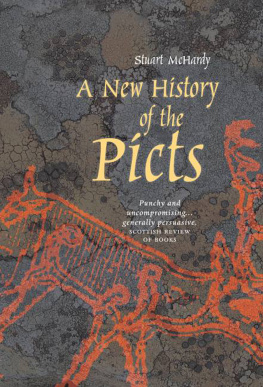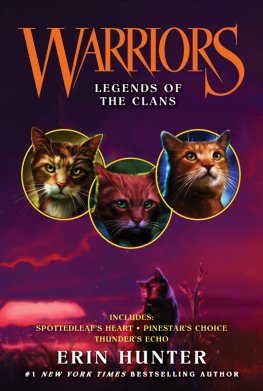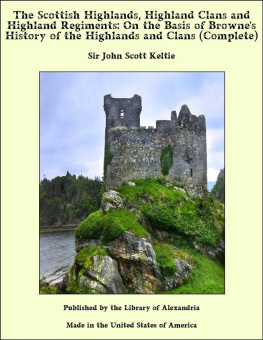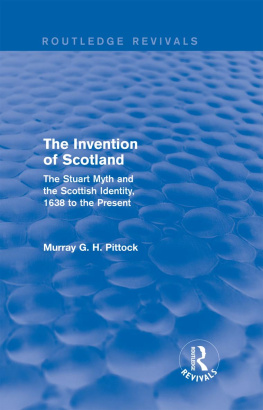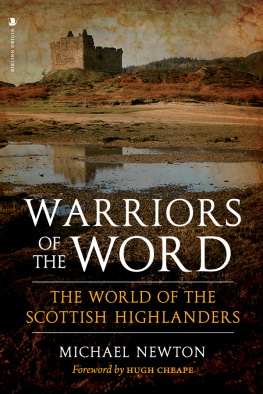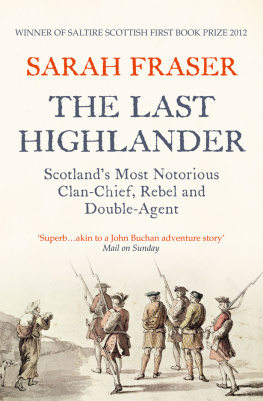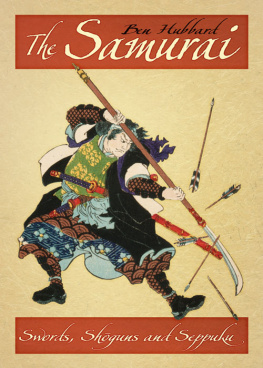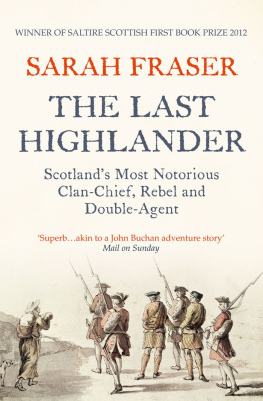First published in 2005 by
Birlinn Limited
West Newington House
10 Newington Road
Edinburgh
EH9 1QS
www.birlinn.co.uk
Copyright Stuart McHardy 2005
The moral right of Stewart McHardy to be identified as the author of this work has been asserted by him in accordance with the Copyright, Designs and Patents Act 1988
All rights reserved. No part of this publication may be reproduced, stored or transmitted in any form without the express written permission of the publisher.
ISBN 10: 1 84158 385 5
ISBN 13: 978 1 84158 385 3
ePUB ISBN: 978 1 78885 302 6
British Library Cataloguing-in-Publication Data
A catalogue record for this book is available from the British Library
Typeset by Hewer Text UK Ltd, Edinburgh
Printed and bound by XXX
To all those whose hearts are in the Highlands
Introduction
In the Highlands of Scotland till modern times there lived a warrior-society that in many ways resembled those that flourished all over Europe in the Iron Age over two thousand years ago. Focused on the central role of the warrior, the Scottish clan system, built round the ties of blood, continued to exist alongside the modern rapidly industrialising society of eighteenth-century Britain. The clans were united by claims of common descent from a distant ancestor and such ancestors could have been Picts, Scots or even Norsemen the peoples who roamed first millennium Scotland. The warriors of the clan, fiercely loyal to each other and to the chief, the centre of all clan life, were known for their remarkable courage and endurance, selfless loyalty and highly developed military skills. Not for nothing were they considered the best fighting men in the world. These skills in time formed the backbone of the British armies that conquered the world the Highland regiments.
The tales collected here illustrate the drama and dynamism of a society that lived close to nature, had little in the way of material wealth but was possessed of an intellectual treasure-house of story and song. That tradition gives us instances of outstanding bravery and cold-hearted deceit, loyalty to the death and the eeriness of the magic and the supernatural.
There are also a couple of stories of clan origin, A Grand Archer being a direct echo of the ancient Norse myth of Orvandel, while the Son of the Carpenter illustrates the roughness of humour that can exist in traditional material. The stories were told round the peat fires of the Highland clans and in many Lowland areas, and served for both entertainment and moral education. Young men learned how to behave, and how not to behave, through such stories. These stories make no claim to being historically accurate. As an example of what can happen, the story of the Battle of Harlaw eventually gave rise to the ballad that claimed that 40,000 men came from the Western Isles, an impossibly large number. Many of these stories might similarly have exaggerated the numbers of warriors involved, but this does not matter. The telling of the stories was an integral part of both Gaelic-speaking and Scots-speaking societies and derived from much older traditions amongst both the Gaelic-speaking Scots and the Picts, who spoke a language akin to Old Welsh.
While historians obsess about the written word though increasingly it is becoming obvious that much of Scotlands supposed early documentation has been adjusted for propaganda purposes the storytellers respected what we might call the psycho-sociological realities that underpin the stories. Stemming from ancient traditions that flourished for millennia without the written word, the stories here give us pictures of an ancient, essentially tribal society that lived in tandem with the emerging modern world.
Much of the material here, as befits a society in which every able man was a warrior, revolves around battle and raiding. Every man was a warrior, but warriors are not soldiers and the men of the clan had ties of blood to the men who led them. They were not linked to their leaders by feudalism but by kinship relationships that had survived intact for incredible lengths of time. Some of these stories concern women of the clans, and it is hardly surprising that they too became involved in battle. Women were always respected in Highland society, though as ever there were exceptions to the general behaviour. Just as there were always men whose self-interest led them to breaking the honour code, so there were men whose lust overpowered whatever sense of decency they might have had. There are tales here of revenge, the dish best served cold. There are also instances of blood-chilling cruelty as in The Smooring of the MacDonalds. However, when we see the remarkable loyalty that could exist within clans, and the remarkable sense of honour and fairness shown in the story Real Highland Hospitality, it is difficult to credit the later government-driven propaganda depicting the Highlander as a thieving savage.
The figure of the Highland warrior, and particularly that of the clan chief, has been the subject of a great deal of Romantic wishful-thinking over the years. They lived in a society that was perhaps an anachronism even by the the eighteenth century, but for those born into it, this was all the world they knew. Hopefully these tales will entertain and help give a picture of what was the last Celtic-speaking warrior society in Europe. By understanding that society better we might yet develop a truer picture of the real history of Scotland.
Edinburgh, 2005
Stuart McHardy
Highland Honour
Real Highland Hospitality
Now for as long as people could remember the Highlanders had loved to hunt. While in the olden times the favourite target would have been the wild boar, a truly ferocious and fearless beast, whose indomitable spirit saw it used as a warrior symbol in many societies, by the Middle Ages it had been hunted to extinction. The main target for hunters then became the red deer, beloved of the kings of Scotland as well as the warriors of the Highland clans. Even to this day, stalking for red deer plays a considerable part in the economy of many Highland estates. Although they enjoyed the hunt, it wasnt just for sport and it was long believed in the Highlands that venison was good for you, especially if you were ill or had been wounded. It also provided a considerable part of most peoples diet. The importance of deer in Highland society can be seen in the stories of the great hero Finn MacCoul, which formed a central part of Highland Gaelic lore. His original name was Demne, which some think meant little deer; his wife Sadv was turned into a deer by a malevolent Druid and their son was called Oisin, or Ossian, which meant fawn.
From an early age Highland lads were instructed in hunting the deer and many of them were addicted to the thrill of the chase. One time a couple of Lamonts from Castle Toward in Cowal were hunting in Forest of Etive. One of them was the son of the chief of the Lamonts who had not long come to manhood. They were heading towards Inverlochy when they met up with the son of MacGregor of Glenstrae and a couple of his friends who were also out hunting. Neither group had had much luck so they decided to try their hand together. The day proved fruitless and that evening the five of them ended up at Kingshouse Inn in Glencoe. What happened next has never been satisfactorily explained, but somehow the two young men fell out. They exchanged words. One thing led to another, and finally young MacGregor lay dead on the floor from a blow by Lamonts dirk! At once Lamont took to his heels and ran off into the hills.


